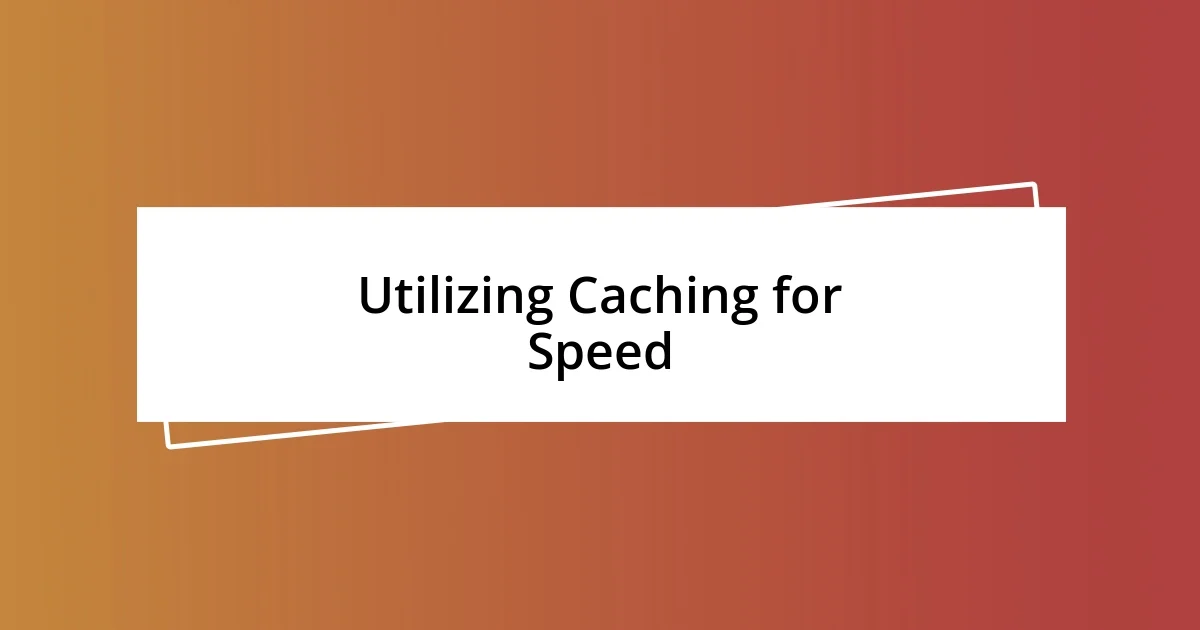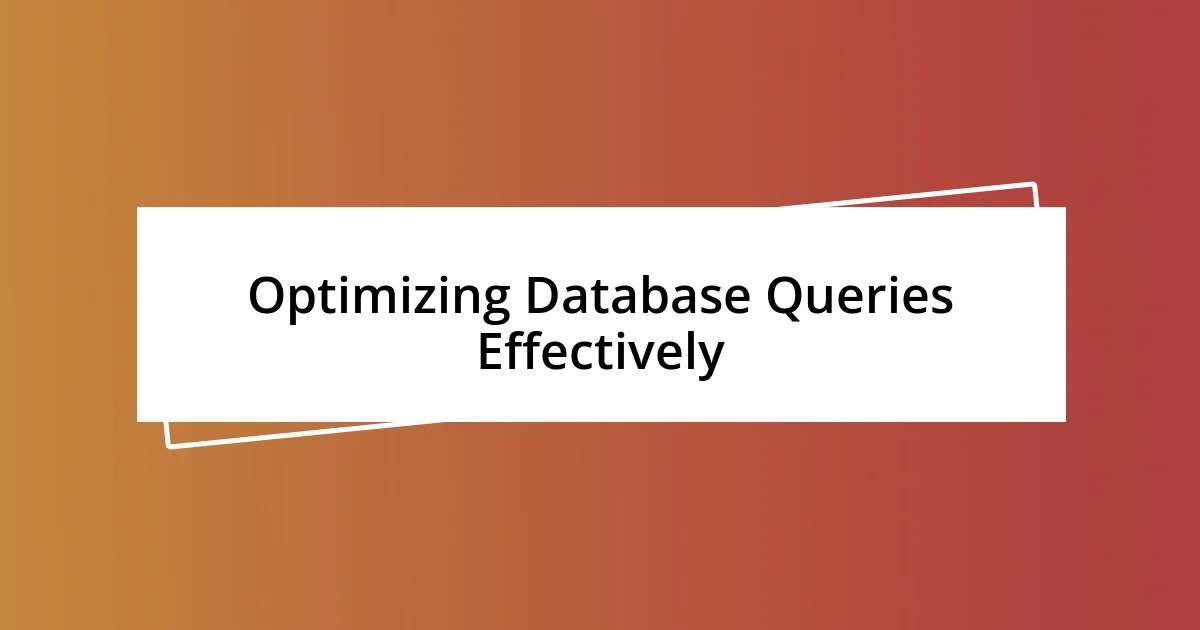Key takeaways:
- Implementing caching strategies, such as fragment and action caching, significantly improved loading times and enhanced user experience.
- Optimizing database queries through indexing, eager loading, and batch processing reduced response times and improved overall performance.
- Utilizing performance monitoring tools like New Relic enabled the identification of bottlenecks, leading to targeted improvements and proactive app management.

Understanding Ruby on Rails Performance
When I first dove into Ruby on Rails, I was struck by its elegance but also by how performance issues can creep in unexpectedly. Have you ever experienced your app slowing down during peak usage? It’s frustrating, right? Understanding how Rails handles requests and database interactions is crucial for addressing these slumps.
One key insight I gained was that every aspect of performance can ripple through the entire application. For instance, I learned to be vigilant about N+1 queries after my app showed a slogging response time. A simple fix like using includes in ActiveRecord can drastically reduce database hits and improve loading speeds. It’s like turning a crowded highway into a well-structured interchange, allowing traffic to flow smoothly.
Moreover, caching became my best friend. I remember implementing fragment caching and seeing page load times drop significantly. It’s amazing how a small adjustment can lead to a more responsive user experience. Have you considered what parts of your app might benefit from caching? It’s a game-changer that I wish I had optimized earlier in my journey.

Identifying Bottlenecks in Your App
Identifying bottlenecks in your Ruby on Rails app can feel daunting at first, but it’s a crucial step in improving performance. I vividly recall the moment I realized how vital it was to monitor the app’s response times. By setting up a performance monitoring tool like New Relic, I could see which parts of my app were dragging down the overall speed. It was eye-opening to discover how even minor changes in a controller action could lead to substantial delays.
Once I narrowed down the culprits, I took a closer look at my database queries. Initially, I was overwhelmed by the sheer volume of data being fetched, which often led to slow loading times. Refactoring to use scoped queries and eager loading not only improved performance but also transformed my development experience. It was like putting my app on a diet—stripping away unnecessary bulk and letting it run freely. Have you ever felt the rush of satisfaction after optimizing a particularly troublesome query?
While database optimization is important, I also found that the frontend could be a bottleneck. I experimented with asset pipeline precompilation and minimized stylesheets and JavaScripts. This transition was challenging but rewarding; watching the page render faster felt like having a brand new app. What bottlenecks might you conquer with frontend optimization?
| Bottleneck Type | Impact |
|---|---|
| Database Queries | High |
| Frontend Assets | Medium |
| API Calls | Variable |

Utilizing Caching for Speed
Implementing caching in my Ruby on Rails app felt like discovering a hidden gem. After I set up caching, I was genuinely impressed by the dramatic speed improvements. I recall one specific instance where a heavily accessed page loaded in just seconds instead of languishing in the 10-second range. It felt like I had given my users the gift of time, as they could navigate my app without waiting endlessly for the content to appear.
Here are some caching strategies I found particularly effective:
- Fragment Caching: This allows me to cache specific pieces of a view, leading to faster load times for most users.
- Action Caching: I used this to cache the output of entire controller actions, which cut down on processing time for frequently accessed pages.
- Page Caching: In scenarios where things rarely change, caching full page responses greatly reduces server load.
- Russian Doll Caching: This clever technique involves nesting fragment caches. When the outer cache is hit, the inner caches are automatically utilized, boosting efficiency.
Embracing these caching methods transformed not only the performance of my app but also my understanding of optimal user experience. While it may have felt like a complex challenge at first, it ultimately became one of my most rewarding achievements during my optimization journey. Have you experienced the thrill of watching your app’s performance jump in response to a caching strategy?

Optimizing Database Queries Effectively
When diving into database query optimization, one of the first steps I took was to analyze my SQL logs. I was shocked to see how many queries were being executed for a single action—sometimes dozens! By identifying the slow, frequently called queries, I realized I could reduce this chaos significantly by using appropriate indexing. Adding an index to often-searched fields not only sped up retrieval times but also made me feel like I was gaining control over my app’s performance.
Another game-changer for me was the implementation of batch processing with Active Record. Previously, I was loading records one at a time, which felt painfully slow. When I switched to .find_each and used bulk inserts, the difference was astounding. Not only did it reduce the number of database calls, but it also transformed a tedious task into a breeze. Have you ever had that “aha” moment when you see just how much more efficient your app can be with a little tweaking?
I also found that leveraging SELECT statements wisely in my queries could lead to substantial performance gains. Initially, I would retrieve entire objects when I only needed a few fields. Changing my approach to only select what was necessary not only improved speed, but it also made my code cleaner. It’s incredible how such a small change can have a profound impact. Have you experienced the thrill of simplifying your queries for a smoother, faster experience?

Leveraging Background Jobs
Leveraging background jobs significantly changed the performance dynamics of my Ruby on Rails app. Initially, I tried to handle all user requests in real-time, which often led to frustrating delays. Implementing background jobs allowed me to delegate tasks like sending emails or processing images to a queue, freeing my app to respond quickly to users. It’s like having a personal assistant; while the heavy lifting gets done behind the scenes, my users enjoy an uninterrupted experience.
I can’t emphasize enough how much I appreciated using Sidekiq for background processing. The first time I set it up, I felt a wave of relief wash over me. Watching tasks being processed seamlessly gave me confidence that my app was handling heavy workloads efficiently. My users could interact with the app without sitting idly, waiting for those back-end tasks to complete. If you’ve ever felt the frustration of slow application speeds, you know how liberating it is to take control of those performance bottlenecks.
Moreover, I discovered the joy of monitoring and managing these background tasks through the Sidekiq web interface. Being able to see failed jobs, retry options, and processing times visually was just so enlightening. It was like receiving a report card on my app’s efficiency! When you have the insight to track what’s working and what’s not, you can make informed decisions that continually enhance the user experience. Do you think your app would benefit from this level of transparency and efficiency in handling background tasks?

Implementing Frontend Performance Techniques
When I turned my attention to frontend performance techniques, the first step was optimizing asset management. I embraced the power of Webpack to bundle my JavaScript files, which reduced the number of requests sent to the server. The relief I felt when I noticed the improved loading speed was palpable—it was like giving my app a much-needed energy boost. Have you ever realized how a few simple configurations could transform the user’s first impression?
Another significant change was implementing lazy loading for images and other non-critical resources. Initially, all media was loaded at once, which slowed down page rendering significantly. Once I introduced lazy loading, assets were only fetched as needed, creating a smooth and responsive experience. I remember the first time I tested it; the difference in performance was dramatic! It made me wonder: how many users clicked away because they were tired of waiting for content to load?
Finally, I prioritized using a content delivery network (CDN). I was initially skeptical, thinking it might be overkill for my app, but the improvement was undeniable. Serving static assets from a geographically dispersed network drastically reduced latency for users around the globe. Watching analytics show increased page views and lower bounce rates filled me with a sense of accomplishment. Have you considered how much a CDN might elevate your application’s performance?

Monitoring and Analyzing Performance Metrics
Tracking performance metrics in my Ruby on Rails app became a game-changer for optimizing its efficiency. At first, I was flying blind; I had no real idea about how different parts of my app behaved under different loads. Then, I started using tools like New Relic and Skylight. These platforms provided me with a detailed view of performance bottlenecks, making it easier to identify areas for improvement. Have you ever noticed how clarity can inspire action?
As I dug deeper into the metrics, I discovered fascinating patterns about user behavior. For instance, I found that specific actions were significantly slowing down my app during peak times. By analyzing these metrics, I realized I had to prioritize tasks that were most critical for user satisfaction. It felt rewarding to implement changes based on actual data rather than just my assumptions. Have you experienced that satisfaction when the numbers finally make sense?
Finally, I made it a habit to review these performance metrics regularly, almost like a wellness check for my app. Integrating monitoring into my routine allowed me to stay proactive rather than reactive. It’s similar to maintaining your health; regular check-ups can prevent bigger issues down the line. How often do you think about the health of your app? This ongoing analysis empowered me to make informed updates that kept my app running smoothly, which ultimately led to happier users.














